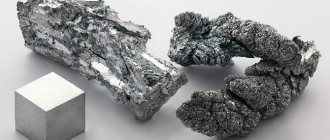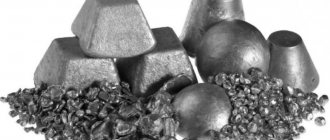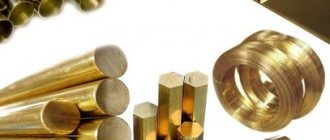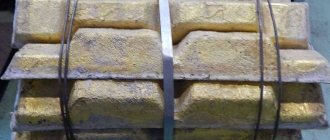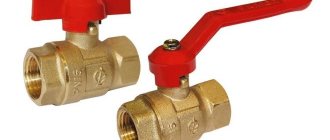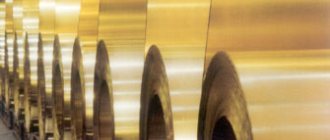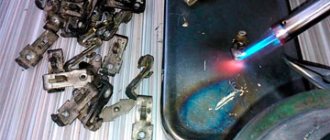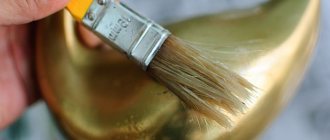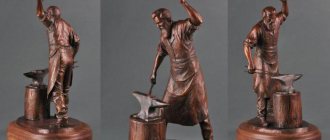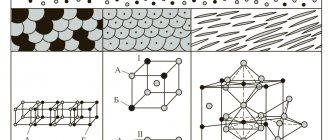Brass, which is well known and has been actively used for many years, is an alloy of copper and zinc. The inventor of this material with a number of unique characteristics is considered to be the Englishman James Emerson, who patented it in 1781.
Brass metal products have good corrosion resistance and high strength
Classification of brass according to various criteria
The main types of brass are classified according to the alloying elements present in the alloy:
- lead brass;
- tin brass;
- manganese brass;
- nickel brass;
- silicon brass;
- aluminum brass.
Depending on the chosen alloy processing method:
- casting brass (used in instrument making, production of bearings, fittings);
- deformable metal brass (used in the production of pipes, wire, sheet metal, brass tape).
Depending on the ratio of zinc in the alloy:
- up to 20% (but not less than 5%) - tombak (or red brass alloy);
- from 20% to 36% - yellow brass alloy.
Physical properties
The characteristics of brass depend on additional alloying elements added to improve process parameters. For example, the density value varies in the range of 8300-8700 kg/m3.
The main physical properties of brass are:
- the specific heat capacity when heated to 20 C is 0.377 kJ kg−1 K−1;
- electrical resistivity 0.07*10−6 Ohm m;
- is not ferromagnetic and does not acquire magnetic properties when exposed to critical temperatures;
- the melting point averages 900 degrees;
- high resistance to corrosion and destruction;
- durable;
- plastic,
- good for forging and processing;
- resistant to temperature changes.
Brass, as a conglomerate of several metals, has a weak conductivity of electric current. Composite metals create distortion in crystal lattices. The resulting voltage fields form the resistivity. Copper itself is an excellent conductor of electric current, which is why all wires are made of copper.
The melting point of brass alloy depends on the percentage of zinc. The more zinc, the easier it is to melt brass.
Rolled brass metal is well suited to arc and gas welding. Well polished and rolled. Resists weathering better than pure copper.
Additions of bismuth and lead to a brass alloy reduce the elastic properties of the metal, making it brittle when exposed to high temperatures (at 500 degrees).
Why are the properties of brass interesting to manufacturers?
Metal brass alloy is characterized by excellent performance:
- resistance to mechanical damage;
- ease of processing under pressure;
- corrosion resistance.
Brass metal as an alloy is not resistant to carbon dioxide solutions, solutions that contain acids of organic origin. to sea water. An alloy with a low zinc content is more corrosion resistant at normal temperatures.
It is not recommended to use an alloy of copper and zinc in the production of parts and products in contact with sulfur dioxide, ammonia, and water.
Areas of application
Brass is used in the following areas:
- Making jewelry from brass. Despite the fact that in the jewelry business only costume jewelry is made from it, the demand for such products is great.
- Due to its plasticity, furniture decorations are forged from it. Fittings are also manufactured.
- If the zinc content is 40%, the alloy is used in shipbuilding, watch movements and aircraft construction.
- Water taps, mixers, and fittings are made from it.
Brass faucet
Alloy brass production
Individual alloying elements can affect the final properties and quality of the resulting alloy. In the manufacture of brass the following can be additionally used:
- tin (affects the final indicators of the alloy’s resistance to corrosion during prolonged contact with salty sea water, expands the range of strength of the material);
- manganese (positively affects the strength of brass and its anti-corrosion qualities);
- lead (used in the manufacture of brass; if the finished alloy is subsequently subjected to metal cutting, this may not have the best effect on its mechanical strength);
- nickel (allows you to increase the durability of brass during its exposure to various environments);
- aluminum (allows you to reduce the volatility of zinc due to the formation of a durable oxide film on the surface of the alloy);
- silicon (provides brass with better weldability, but reduces the hardness of the resulting alloy).
Advantages of joining brass parts using argon-arc welding
It is not for nothing that experts consider argon arc welding the best method for joining brass parts. It has many advantages, among which the most significant are versatility (you can connect both small and large elements) and process safety. There are others:
- no flux or special expensive electrodes are needed;
- environmental friendliness;
- high speed of work;
- the seam is not only durable, but also aesthetic;
- absence of slag on the weld surface;
- oxide and nitride crusts do not appear during the welding process;
- inert gas supplied to the junction of parts displaces dangerous compounds arising from the oxidation of zinc.
Inert gas allows you to protect the cleaned edge of a metal part from the influence of external air. The argon flow prevents the formation of slag, crusts of oxides and nitrides, and harmful chemical compounds.
How brass is obtained in production
The production of brass is carried out according to technological maps developed in the zinc and copper industries. Alloys are often obtained by recycling raw materials: copper billets, zinc waste, etc. Recycled raw materials are especially often used during the casting of brass with additional elements.
Brass casting is a complex process made possible by the presence of different types of melting furnaces in production. Modern low-frequency (induction) furnaces, equipped with an additional magnetic core, are in particular demand among technologists.
It must be taken into account that during the melting process of metals, their partial evaporation occurs. Therefore, casting can only be done with powerful industrial exhaust ventilation. There is also a risk of the components of the future alloy catching fire during the casting process - it is necessary to constantly monitor the temperature in the melting furnace to eliminate the possibility of overheating.
Before starting to manufacture brass of a certain composition, the furnace must be completely cleaned. Then the copper will be heated in it to a state of red heat, after which zinc blanks are added. To prevent the oxidation of zinc, copper in alloys is always added first.
In order to obtain cast brass, the alloy molten in a furnace is poured into pre-prepared molds. As a result, the alloy solidifies and forms round, flat ingots. After the casting process is completed, further work can be done with the alloy. For example, subject it to heat treatment in order to increase strength indicators, perform aging and hardening of the alloy, and deform the ingots if necessary.
Injection molding
Injection molding is a high-performance automated technological process for creating thin-walled parts from non-ferrous metals, steel and plastics.
At high speed, the liquid melt fills the mold. and then, as a result, castings of a given shape are obtained under pressure.
This article describes in detail the technology, equipment and products that can be obtained using the method.
Description of technological operations
The injection molding process is carried out in steel molds. The molten material is fed into the mold and crystallizes there under high pressure.
A mold is a technological casting equipment constructed from movable and fixed steel parts. The movable half moves along guide cylinders, the fixed half is fixed on a stationary plate.
Before pouring, the moving part is pressed tightly against the stationary part by a hydraulic cylinder and fixed in this position with special locks. After the workpiece hardens, the moving part of the equipment moves away, and the casting is pushed out by mechanical pushers.
Before closing the mold, the surfaces in contact with the molten metal are coated with a release agent.
The special composition ensures smooth separation of castings after casting and protects the steel from the negative effects of high temperatures.
Injection molding is performed automatically in industrial plants. The main unit of this equipment is the pressing chamber; it can be cold or hot.
The cold chamber is a horizontal cylinder with a piston inside and a funnel designed to pour in the melt. After pouring the metal, the piston moves inside the cylinder, pumping the melt into the mold.
After filling the mold, the force on the piston increases to create sufficient pressure to crystallize the metal.
The hot pressing chamber is a molten bath located in a heated cast iron crucible. The forward movement of the piston pushes the melt out of the crucible. The metal rises through the channel and enters the mold. The channel design includes a heated mouthpiece. This element is needed to prevent the liquid metal from solidifying inside.
After the part has solidified, the remaining melt from the channel is drained back into the cast iron bath. Equipment of this type is used for products made of zinc and magnesium alloys.
Melt heating temperature
Heating of the material for injection molding is carried out based on the grade of the alloy and the geometric parameters of the part. If the melt is overheated, when filling the mold, splashes enter the ventilation holes and clog them. This leads to deterioration of the gas outlet and, as a consequence, to the appearance of pores in the casting.
The high temperature of the liquid metal leads to an increase in the solidification time of the product, as a result, more time is needed for the entire technological process.
Equipment wear increases due to prolonged contact with the superheated melt.
The danger of welding the poured metal to the equipment increases, which can cause damage to the part when being pushed out. All this leads to rapid wear of the mold.
In injection molding, the melt is compressed at a minimum temperature. Non-ferrous metals are heated only 10–300ºС above the temperature at which the alloy completely hardens. With small thicknesses of casting elements, the alloy must be heated more strongly. To cast large products with simple configurations, the alloy is heated just above its melting point.
For parts that have high strength requirements, the metal is poured in a solid-liquid state. This provides the following benefits:
- prevent the appearance of shrinkage defects in the casting;
- reduce thermal impact on equipment;
- reduce the cooling time of the product;
- reduce the risk of welding of the mold and casting.
Metal with inclusions of the solid phase can be pressed only in installations with a cold chamber. When using equipment with a hot chamber, there is a risk of melt solidification in the supply channel.
An example of injection molding of aluminum parts is the percentage of solid particles in the melt, when the mold is filled smoothly and the quality of the casting remains at a high level, ranges from 40 to 60%.
Melt feed rate into the mold
The piston compresses the metal into the mold at a certain speed. The value is selected depending on the characteristics of the alloy and the geometric parameters of the casting.
If the product is simple with thick walls, high pressing speed is not needed. If the part has complex geometry and thin elements, the pressing speed must be high.
This is required so that the melt has time to fill all narrow cavities before solidification.
Too high a flow rate of molten material causes the following phenomenon: the jet will split into small droplets, forming a mixture of melt and air. If the number of channels for exhaust gases is insufficient or they are clogged with metal, air bubbles will remain in the casting. This will lead to the formation of pores in the metal; to eliminate such defects, the mold is placed in a vacuum.
The quality of castings and the durability of equipment depend on the speed of movement of the melt. If the injection molding speed is too high, the protective lubricant may be washed off from the surfaces in contact with the liquid metal. This will cause the casting to weld to the mold and may damage or break when pushed out.
Feeding too slowly will reduce the quality of the part. The metal will solidify while the mold is being filled before the force is increased. The speed at which the melt enters the mold during injection molding is usually selected in the range from 10 to 50 m/s. Low speed is used for casting parts made of steel and copper alloys; high speed is required for tin and zinc alloys.
Pressure on the melt during solidification
At the moment when the melt completely fills the mold, the force on the piston increases many times. The pressure does not stop until the metal has completely hardened.
As a result, the density and mechanical characteristics of the casting increase, and shrinkage defects do not form in it.
With increasing compression force, the number of defective products decreases, the cleanliness of the metal surface increases, and the quality of castings improves.
The higher the requirements for the strength of the part, the greater the pressing force must be. Aluminum alloys are pressed at pressures from 40 to 200 MPa. For magnesium-based alloys, from 40 to 180 MPa are used. Zinc alloys are subjected to pressure from 10 to 50 MPa. To ensure high quality, as the wall thickness increases, the pressure during crystallization must be increased.
Mold heating temperature
Before feeding the liquid alloy, foundry equipment must be heated to a certain temperature, which is selected for each alloy depending on the wall thickness of the product. Mold preheating temperature:
- for zinc casting up to 120–1600 ºС;
- magnesium 200–2400 ºС;
- aluminum 180–2500 ºС;
- steel 200–2800 ºС;
- brass 280–3200 ºС.
If the casting is thin-walled, the mold is heated to a temperature closer to the higher values of the above intervals. For thick-walled parts - closer to the lower value. This is necessary so that in thin-walled castings the melt does not harden during the filling of the mold. In the technology of pouring large parts, on the contrary, it is necessary to increase the solidification speed.
Advantages and disadvantages of injection molding
Castings made on injection molding machines are parts with low roughness, high precision, which do not require mechanical processing or it is minimal. After casting, the parts are sent to cutting presses, where the sprues and washers are removed from them.
A process consisting of a small number of operations can be fully automated. Due to the simplicity of operations, rapid solidification of the metal and automatic removal of products, this process is highly productive.
The disadvantage of the technology is the complexity and high cost of technological equipment. It is not economically rational to use injection molding in medium-scale and small-scale production. The method is not suitable for casting refractory metals that melt at a temperature higher than steel.
This technology is not used for the production of large castings, since the advantages of the method disappear due to uneven solidification, and due to the high price of large-scale high-precision equipment, the use of this method is not economically feasible.
Application
Injection molding produces thin-walled parts with complex geometries. This technology makes products from copper, aluminum, zinc, magnesium alloys, steel and plastic. This technology makes it possible to perform geometrically complex castings with element thicknesses up to 1 mm.
Injection molding is used in the following industries:
- instrument making;
- automotive industry;
- aircraft manufacturing;
- machine tool industry;
- production of mixer elements.
- production of household appliances;
Injection molding is widely used for the production of products from polyethylene, polypropylene and other synthetic materials. Due to the high cost of the equipment used, this technology is economically justified only in mass or large-scale production.
Today, not a single machine-building enterprise that mass-produces parts for household appliances, appliances, internal combustion engines and other high-tech mechanisms can do without injection molding installations.
Main areas of use of brass alloys
In mechanical engineering, brass alloys are used for the production of adapters, bushings, and cooling systems for engines. In construction, this alloy is often used in the manufacture of pipe fittings and individual elements of plumbing equipment.
Brass often becomes a material popular in the design environment: its presentable appearance allows numerous interior components to be made from alloys.
April 16, 2017
Share with friends:
Similar alloys and materials
It is easy to distinguish from pure copper by the color of the features. For this you need a regular porcelain plate. On its lower side there is an unglazed, that is, rough, not covered with glaze “rim” - on it the plate stands on the table, preventing it from sliding.
If you rub a copper product against this area, it will turn a copper-reddish color. Brass will leave a grayish-yellowish mark. Gold has a light golden streak color.
Similar steel products are magnetic, silver ones have a grayish-white color.
Bronze is made by fusing copper with tin. Its color is similar to brass (except for tombak), but visually you can catch a barely noticeable reddish tint.
If you have access to a powerful burner (but this method is unsafe), then the metal should be heated to 600 degrees: the brass will become covered with a grayish coating of oxidized zinc and will bend (bronze will break). However, reliable differences between these two alloys are obtained only by spectral analysis.
Advantages and disadvantages
Every metal has special properties that can be attributed to both advantages and disadvantages. It all depends on the situation. Brass is used extremely rarely in construction, which is more evidence of the relevance of other materials, and not at all of the disadvantages of the alloy.
The main advantage of brass is its low weight, which makes the material popular in rocket and aircraft construction. In domestic conditions, this is only necessary in situations where, for example, a light water supply system is needed.
The alloy also has excellent decorative properties. It has a very varied and attractive color palette. Accessories and fittings, household and decorative items made with brass will always be beautiful, emphasizing the luxury and elegance of the interior. At the same time, the color of brass remains for a very long time.
The material also has low thermal conductivity , which is often used for the manufacture of systems and objects for which heat retention is very important. We are talking about the production of bathtubs or furniture.
Brass is a diamagnetic metal, meaning it will be pushed out of any magnetic field. This alloy has been used for the production of compass frames for a long time. Now this quality is actively used in instrument making.
The corrosion resistance of the material is even greater than that of ordinary copper, but it decreases greatly as temperatures increase. Therefore, it is very beneficial to use brass pipes for water supply. For the heating system, it is still better to take a copper pipeline.
